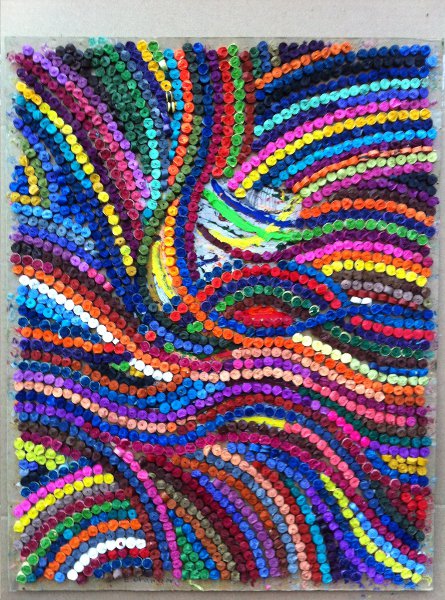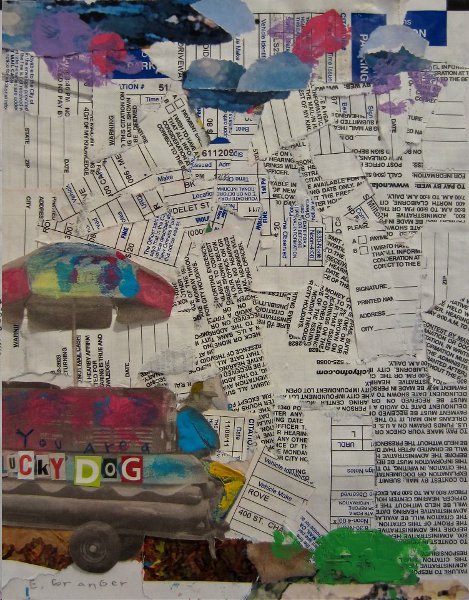Eddie Granger Takes an Uninhibited, Optimistic Approach to Creating Masterful Art

Since the inception of Expressionism in the late 19th Century, the art world has conceded to the “Van Gogh Effect,” a term drawn from the pervasive tendency to romanticize an artist’s suffering in relation to his art. As a result, society has come to understand artists as outsiders, haunted and alienated by their own ingenuity. While many critics still savor the idea of the despondent artist, a new trend is beginning to emerge – happiness.
Simple in theory yet deceptively difficult to convey, New York-based artist Eddie Granger has made it his artistic mission to bring back the somewhat unfashionable idea of optimism. “I’m tired of seeing art that is silent or morbid,” he explains. “Everyone thinks that art needs to be really sensitive or dark. Can we divert from this dark place everyone thinks they need to go? Can we do something different?”
Originally from Louisiana, Granger has recently begun to make a name for himself in the New York City art world through his assemblage work formed entirely of cut crayons. These idiosyncratic pieces are hard to classify. Granger manages to maintain a painterly quality in his work, through the fluidity of line and organic composition. They are too sophisticated to be decoupage yet utilize traditional collage techniques by turning objects into artistic forms. Some canvases in his studio are covered entirely in crayons, depicting rich color differentiations and complex designs, while others reveal flowing, overlapping lines intimating the canvas as its own medium. Hints to his process and allowance for slight errors are all visible on the bare canvas surface.

One is inclined to draw comparisons between Granger’s penchant for a reduced, primary color-palette, and that of the Fauves in the early part of the 20th Century, especially when considering Granger’s ties to French Creole art, which often includes large fields of color. When asked how he begins a project, he responds similarly to how one might assume a Primitivist would. “A word that that we use in French is savage,” he recalls. “It means the wild one or one who has no inhibitions. That’s how I view myself. I just go at it, with no expectations. It is how I relate back to my French background. That’s how I was raised.”
In fact, art has always been a part of Granger’s life. After attending an arts academy in Louisiana from elementary through high school, he went on to study architecture in college. As the artist put it, “It was something that would liberate me from my family and friends because I always felt like an outcast. My family wanted me to play sports but I didn’t want to. Art really allowed me to be free.”

Personal liberation is perhaps the most important factor in Granger’s work. Always true to his tranquil existence, the message behind his work is clear. “ When people see my work, I want them to see freedom,” he offers. “I feel that everyone should be free. Everyone should love. Everyone should be very playful and not take things too seriously. No matter how mature my work, I want that feeling of freedom. If that’s what people can get from that, perfect. My job is well done.”
Granger’s independence reaches well beyond his artistic product. In fact, his artistic process is the driving factor in his day-to-day life. A self-proclaimed “sponge of information,” the artist likes to start his days out slowly letting everything he encounters serve as an inspiration in his work. Mundane objects become visual references, encounters with friends commence new ideas, and listening serves as a means of absorbing chaos and relaying that back as a visual resource.
In addition, readings and passages play an important role in Granger’s creative methodology. A lot of his pieces are titled after quotes he has interpreted in his own way and turned into art. Granger finds power and context from even the most minimal phrases. One of his favorites being, “I tried to find you but I got lost in my imagination.” Like crayons, Granger reverts these words back to childhood nostalgia. “I ultimately feel that’s how children think. A child has a wild imagination. They don’t take things too seriously. That is how they grow, learn, and become the person they are.” He says, ”Those who are scared, don’t accomplish anything.” To the artist, getting lost is the only way to find oneself, just as working is the only way to learn.

Talking with Granger is a captivating experience as every part of his personality is reflected in his work. He mentally collects information and physically collects refuse, using both as inspiration for his Recycled Art. He is noticeably attractive and personable, reinforcing his belief that an artist should be involved in society, not aloof and separate.
Most importantly, Granger is young at heart, sophisticated, yet on a constant quest for ideas. This search has led him from crayon drawings to paintings and then back to his original medium. He likes crayons because they recall youth in their smell and in their association. However, his use diverges from the meaning they had in childhood, taking them on as a medium in and of themselves. “I wasn’t using the crayons to make something,” he notes.” I was making something out of the crayons.” The resultant oeuvre of spirited work emphasizes painterly qualities and color over direct representation and realistic values.
Granger’s accomplishments extend well beyond his collage work. He also works extensively on large-scale oil pieces, piles recycable objects onto canvas then removes them one by one in order to release color and space through a growth and decay process, and is working on designing a handbag to be premiered at this year’s Art Basel Miami Beach. Despite these many ventures., his character remains consistent. Similar to the negative space on his canvases filled with subtle creative remnants, when it comes to Granger’s future, there is a greater story to be told.
For more information about the artist, visit www.eddiegranger.com
Author Bio:
Kristin Sancken is an art critic at Highbrow Magazine.































































































































































































































































































































